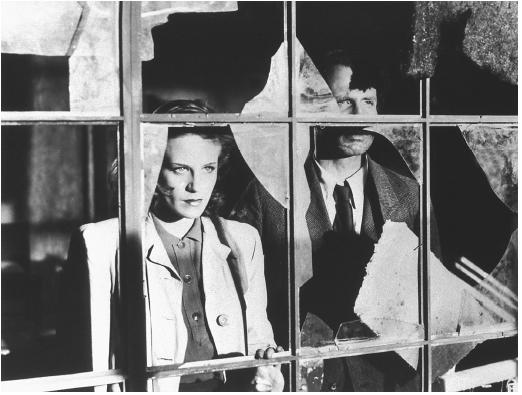 |
The still, left, has been taken from the opening scenes of the first German feature film produced after the war, Wolfgang Staudte's The Murderers Are Among Us, 1946 (Die Mörder sind unter uns). This film made in the Soviet Occupation Zone sets the scene for the German War Films of the 1940's taking its name from the broken buildings, bricks, stones and mess in the street. They gave us the main theme of films until 1949; rubble.
The Murderers Are Among Us, 1946
Die Mörder sind unter uns
Soviet Zone of Occupation
Dir: Wolfgang Staudte
Wolfgang Staudte's film sets the scene for post war film. It tells the story of a former Wehrmacht doctor's love affair with a former concentration camp victim. They share a flat and the doctor is suffering from shell shock and refuses to face up to his past. He discovers that his former commanding officer, who committed a war crime, is prosperous and living a happy life in Berlin. Surrounded by the ruins of Berlin the doctor swears revenge, but is stopped by his lover who claims, " we don't have the right to revenge....."
The film is set and was shot in the fantastic ruins of Berlin, shot as an expressionist film, the ruins become the 4th character towering over the action, towering over the characters. The ruins represent the ruined lives of the German people. Berliners are living in cellars and the ruined buildings, the ruins have become their lives. Staudte's tense message seems to be, the German's can only move forward if they remove the ruins from their own lives before they can deal with the ruins in the streets.
Staudte's film established two traditions in German post war film making, the Rubble Film, which was to be influencial across Germany in the immediate post war period, and the East German Anti-Fascist tradition. The Anti-Fascist tradition attempts to explain the causes of National Socialism, criticise National Socialism and distance East Germany from any responsibility for National Socialism and the war.
This film is available from amazon.co.uk here (Note this is an NTSC version but with English subtitles)
This film is available from amazon.de here
To see a longer presentation about this film and Anti-Fascist film click here.
Above the Heaven (1947)
Und über uns der Himmel
American Zone of Occupation
Dir: Joseph von Baky
Directed by Joseph von Baky and the first film produced in West Berlin.
It tells the story of crane driver Hans Richter, played by Hans Albers who was known as the Blond Hans and already a fixed star of the 1940's cinema, return to Berlin. He returns to his ruined block of flats to find out who has survived the war. He is greeted by a small girl, who thinks that he is her father. The child is the daughter of Edith Schröder, a war widow. Edith struggles to make ends meet and to explain that Hans is not her father but her neighbour, her “Onkle”.
In the collapsed and listless world of Berlin, where Germany’s ruin is laid out for all to see, Hans struggles to find work as a crane driver, none of his friends have work and they all strive for more “Kalorien”. In an effort to better himself and provide food for himself and Edith, Hans is slowly drawn in to the murky world of the black market. The other residents of the flats share the same struggles and are living barely above the bread line, all that is except Mizzi. Mizzi is a beautiful blond woman, whose boyfriend cannot get work because his papers are not in order, and she is able to trade on her good looks in the black market night club Haiti, where Hans becomes a regular customer.
Hans and Mizzi are able to afford calorie rich food and colourful clothes while those around them survive on their bare rations and what they are able to trade on the black market. This situation looks set to continue, until Hans’ son, Werner, returns from POW camp and hospital. The stress of war has caused him to go temporarily blind. He is unable to see what his father has become and see how Hans’ flat has been renovated and redecorated from the profits of his black market dealings while his neighbours’ flats are still shabby and war torn. After medical treatment, paid for by Hans’ black market dealings, Werner is able to see and his eyes are literally opened to what Berlin and his father have become. Werner rejects his father and his father’s black market ways. This act of rejection brings Hans to his senses; he puts away his fine clothes, for the moment, and returns to his workers clothes and his job as a crane driver.
The film sympathetically deals with the returning Soldier, his troubles and attempts at finding a role for himself. It was made in a time of hunger and is very critical of profiteers and the black market.
This film can be purchased here from Amazon.de

